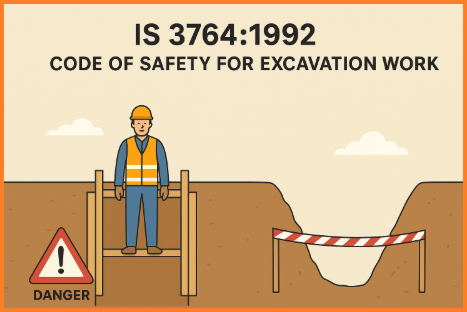Excavation is one of the most fundamental and hazardous activities in construction. Whether for trenches, foundations, road cuttings, or utility pipelines, excavation exposes workers to risks, including cave-ins, falling material, hazardous gases, and accidents involving machinery. Recognizing these dangers, the Bureau of Indian Standards (BIS) published IS 3764:1992 – Code of Safety for Excavation Work, laying down safety measures to minimize accidents and safeguard workers’ lives.
Contents
1. Scope of the Standard
The standard applies to excavation works such as:
- Trenches, test pits, cellars, borrow pits, canal and road cuttings.
- Excavations where sides are not simultaneously trimmed to a stable slope.
Exemptions:
- Trenches less than 1.5 m deep.
- Trenches where no entry of persons is required.
- Mechanically excavated and backfilled pipeline trenches.
2. Responsibilities
Supervisors and Foremen
- Must be competent, experienced, and responsible for enforcing safety rules.
- Inspect excavation sides regularly, especially after rain or storms.
- Ensure underground structures (pipes, cables, sewers, etc.) are identified before digging.
- Provide first-aid facilities at site.
Workers
- Must use personal protective equipment (helmets, boots, gloves, safety belts).
- Should be properly trained and briefed on hazards.
- Must refuse unsafe work and immediately report hazards to supervisors.
3. Shoring, Timbering, and Sheet Piling
Proper support systems are essential to prevent trench collapse:
- Shoring & Timbering:
- Mandatory for trenches deeper than 1.5 m in soil and 2 m in unstable rock.
- Members such as sheathing, wales, struts, and cleats must be placed correctly.
- Timber or other strong materials should be used.
- Sheet Piling:
- Recommended when slopes are impractical, nearby structures exist, or soil is fluid.
- Can be timber, steel, concrete, or composite piles.
- Inspection:
- Must be done before work begins, after blasting, and following rain/storms.
4. Excavated Material and Berms
- Excavated earth must be kept at least one-third of trench depth away from the edge (minimum 1 m).
- Tools, wheelbarrows, and other equipment should be stored away from edges to prevent falling.
- Materials must not be piled against walls or near power lines.
5. Machinery and Vehicles
- Heavy equipment should not operate closer than the depth of the trench (or 6 m if trench >6 m).
- Trucks must not be backed near trench edges; stop-blocks should be provided.
- Power shovels and draglines can destabilize trench sides – their use must be closely monitored.
6. Access, Escape, and Barricading
- Pathways & Gangways: Minimum width of 75 cm, non-slippery, with guardrails if elevated.
- Ladders: At least one ladder per 30 m length (1.5 m spacing in hazardous work). Must extend 1 m above trench edge.
- Fencing & Guards: Trenches accessible to the public must have barricades and danger signage.
- Lighting & Signals: Adequate lighting for night work and warning signals for vehicles and pedestrians.
7. Special Hazards
a) Loose Side Material
- Remove loose stones, unstable earth, and projecting clumps.
- Prevent workers from working directly one above the other.
b) Gases and Fumes
- Ensure oxygen content is ≥19% and carbon dioxide ≤1%.
- Ventilate trenches where gases may accumulate.
- Combustion engines inside trenches must have safe exhaust systems.
c) Insects, Snakes, and Poisonous Plants
- Workers should be provided protective gear, repellents, and first-aid remedies.
- Training for identification of poisonous plants is essential.
d) Overhangs and Slopes
- Remove overhangs before further excavation.
- Break down unstable slopes and prevent workers from entering danger zones.
e) Water and Weather
- Watch for water saturation after rainfall.
- Freezing and thawing cycles may loosen trench walls.
8. Safety Provisions
- Lifelines & Safety Ropes: Workers entering hazardous trenches must wear safety belts with lifelines anchored securely.
- Shelters: Provide safe shelters for workers away from trench walls during breaks or storms.
- Supports for Foundations: Adjacent foundations must be supported with bracing or underpinning.
- Walkways & Bridges: Guardrails required where depth exceeds 2 m.
9. Common Hazards in Excavation
The code highlights key risks:
- Quicksand requiring close sheathing.
- Water saturation weakening trench walls.
- Vibrations from machinery or traffic.
- Adjacent fills or surcharges from nearby structures and heavy loads.
Conclusion
The IS 3764:1992 – Code of Safety for Excavation Work is a comprehensive guideline that emphasizes planning, supervision, worker training, protective systems, and emergency preparedness. Following these safety principles significantly reduces accidents, protects workers from fatal cave-ins, and ensures smooth progress of construction projects.
For contractors, engineers, and safety officers, strict compliance with this standard is not only a legal requirement but also a moral responsibility towards safeguarding human life in hazardous excavation operations.





